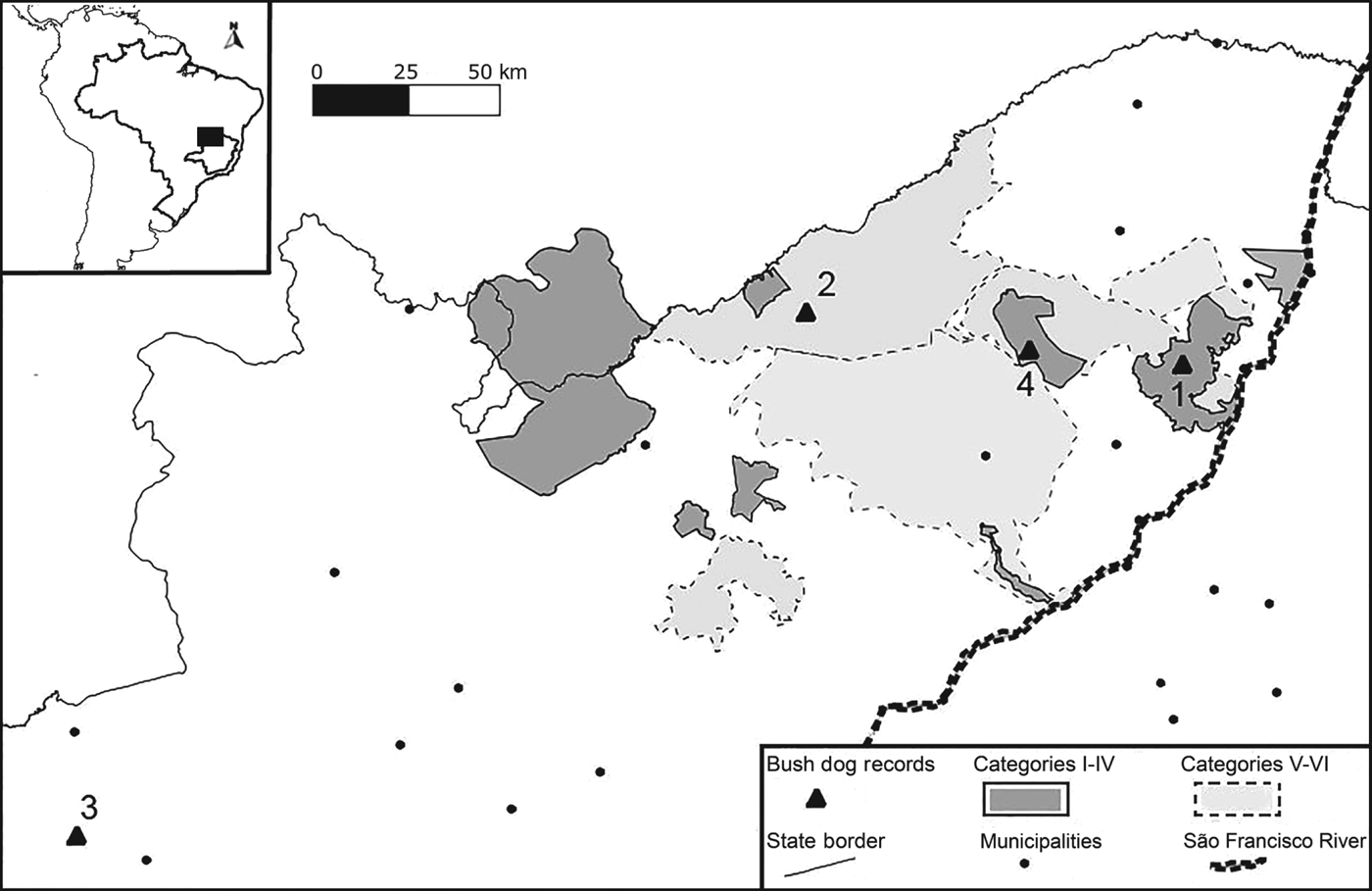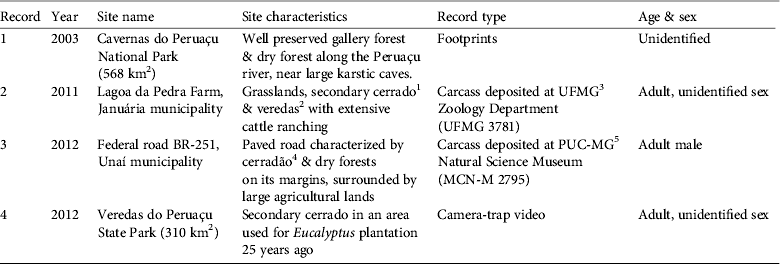The bush dog Speothos venaticus is the most social of small canids (Eisenberg & Redford, Reference Eisenberg and Redford1999) and can hunt relatively large prey such as caviomorph rodents (Zuercher et al., Reference Zuercher, Gipson and Carrillo2005) and armadillos, especially Dasypus novemcinctus (Lima et al., Reference Lima, Jorge and Dalponte2009). Few aspects of its ecology and behaviour in the wild are known, and before the studies by Zuercher et al. (Reference Zuercher, Gipson and Carrillo2005) and Lima et al. (Reference Lima, Jorge and Dalponte2009, Reference Lima, DeMatteo, Jorge, Jorge, Lima, Dalponte and Klorfine2012) most of the information about the species came from occasional encounters (e.g. Silveira et al., Reference Silveira, Jácomo, Rodrigues and Diniz-Filho1998) and observations in captivity (e.g. Macdonald, Reference Macdonald1996). The bush dog is categorized as Near Threatened globally (DeMatteo et al., Reference DeMatteo, Michalski and Leite-Pitman2011) and as Vulnerable in Brazil (Machado et al., Reference Machado, Drummond and Paglia2008). S. venaticus was previously considered extinct in Minas Gerais state (Costa, Reference Costa, Machado, Fonseca, Machado, Aguiar and Lins1998) and, although it is currently categorized regionally as Critically Endangered (Chiarello et al., Reference Chiarello, Aguiar, Gregorin, Hirsch, Melo, Paglia, Rodrigues, Drummond, Machado, Martins, Mendonça and Stehmann2008), the rediscovery of the species has not been properly documented.
The state of Minas Gerais in south-eastern Brazil harbours three major ecosystems: Atlantic Forest, Caatinga and Cerrado. Caatinga is a mosaic of thorn scrub and seasonally dry forests associated with a semi-arid climate, and Cerrado is a savannah formed of several vegetation physiognomies. Here we describe four recent records of S. venaticus in Minas Gerais state (Table 1, Fig. 1), the first there since the species was first described (Lund, Reference Lund1842).

Fig. 1 Location of the four recent records of the bush dog Speothos venaticus (Table 1) in the state of Minas Gerais, south-east Brazil. Only protected areas within the Protected Areas Mosaic Sertão Veredas–Peruaçu are shown. Categories refer to the IUCN protected area categories (Dudley, Reference Dudley2008). The filled rectangle on the inset indicates the location of the main map in Brazil.
Table 1 Details of the four recent records of the bush dog Speothos venaticus in Minas Gerais state, south-eastern Brazil (the record numbers correspond to the numbered locations in Fig. 1).

1 Typical Cerrado ecosystem physiognomy, sparse trees and large shrubs 2–8 m tall with a grass ground layer
2 Humid grassland vegetation dominated by the palm Mauritia flexuosa
3 Universidade Federal de Minas Gerais
4 Tall Cerrado vegetation with large trees
5 Pontifícia Universidade Católica de Minas Gerais
In 2003 we found bush dog footprints in Cavernas do Peruaçu National Park, northern Minas Gerais, in the transition zone between Cerrado and Caatinga. Despite our considerable camera trap efforts (c. 7,000 trap-days at 30 sites) the species was never recorded again in this Park. In March 2011 a bush dog carcass was found in an extensive cattle ranch in northern Minas Gerais, after a local resident reported that three of his domestic dogs attacked two bush dogs and killed one of them. The site is within Cochá Gibão Environmental Protection Area (IUCN category V) and c. 8 km from the 70-km2 Porto Cajueiro Private Reserve. In May 2012 a bush dog was found run over on the paved road BR-251, in the municipality of Unaí, in the north-west of the state. The site is not close to any protected area. In September 2012, at Veredas do Peruaçu State Park, we obtained the first camera-trap image of S. venaticus in Minas Gerais. Sightings of bush dogs had been reported by staff of this Park since 2004 but the species was recorded only 7 years after our first attempt to confirm its occurrence (in c. 6,000 camera-trap days at 70 sites).
All these records are from the north and north-west of Minas Gerais, where relatively large areas of Cerrado and dry forest remnants still occur, and from where we expect any new records of the bush dog to be found. Three of the four records were either inside or close to strict protected areas (IUCN categories I–IV), in a region officially recognized as the Protected Areas Mosaic Sertão Veredas–Peruaçu, which is one of the most important areas for long-term conservation in south-east Brazil, extending over 18,000 km2 and largely covered with natural habitats. The Peruaçu River watershed, where two of the records were obtained and where the species is often reported by local people, appears to be an important area for conservation and studies of the bush dog in south-east Brazil.
We have been studying large mammals in the Protected Areas Mosaic Sertão Veredas–Peruaçu since 2004. These studies used techniques suitable for recording bush dogs, such as searching for tracks, track plots and camera trapping (totalling c. 27,000 trap-days). Despite this effort, S. venaticus was recorded only on three occasions. Similarly, Beisegel (Reference Beisegel2009) and Fusco-Costa & Ingberman (Reference Fusco-Costa and Ingberman2013) reported that the bush dog was recorded in the Atlantic Forest only after 4,800 and 4,112 trap-days, respectively. In the Brazilian Amazon, Michalski (Reference Michalski2010) obtained an average of one camera trap record for each 3,361 days of sampling. In Emas National Park, central Brazil, bush dogs were seen only nine times in 33 years (Silveira et al., Reference Silveira, Jácomo, Rodrigues and Diniz-Filho1998). These facts indicate that the bush dog has an extremely low probability of detection (which may result in false absences), probably caused by the synergistic effect of the species’ large home range and its use of armadillo burrows as rest sites (Lima et al., Reference Lima, DeMatteo, Jorge, Jorge, Lima, Dalponte and Klorfine2012), in conjunction with small population sizes and low density. There is a need to improve techniques to detect S. venaticus. Playback vocalizations (DeMatteo et al., Reference DeMatteo, Carrillo, Zuercher, Ramírez, Smith and Porton2004) combined with camera trapping can provide insights about pack size, and detection dogs can be useful to find scats and dens (DeMatteo et al., Reference DeMatteo, Rinas, Sede, Davenport, Arguelles, Lovett and Parker2009; Lima et al., Reference Lima, Jorge and Dalponte2009).
The two carcasses were found in disturbed environments. Although S. venaticus can occur in such areas (Oliveira, Reference Oliveira2009) these are not optimal habitat for the species, and mortality may be high. Lima et al. (Reference Lima, DeMatteo, Jorge, Jorge, Lima, Dalponte and Klorfine2012) observed that bush dogs prefer natural habitats, avoiding cultivated lands even in a highly fragmented area.
As S. venaticus is exclusively carnivorous (Zuercher et al., Reference Zuercher, Gipson and Carrillo2005; Lima et al., Reference Lima, Jorge and Dalponte2009, Reference Lima, DeMatteo, Jorge, Jorge, Lima, Dalponte and Klorfine2012) its occurrence is conditional on the presence of prey. The species' main prey occur in the protected areas in the Protected Areas Mosaic Sertão Veredas–Peruaçu (Fundação Pró-Natureza, 2003; Ferreira et al., Reference Ferreira, Oliveira, Moraes, Silva and Rodrigues2011). Some of these protected areas may support large prey populations and thus prey depletion is probably not a major threat to bush dogs in the region. The main threats in the short- and medium-term may be related to contact with domestic dogs and loss of habitat. Domestic dogs can kill bush dogs, and may transmit diseases (Jorge et al., Reference Jorge, Pereira, Morato, Scheffer, Carnieli and Ferreira2010). Measures are required to eradicate domestic dogs from areas managed strictly for conservation. In protected areas where human populations are allowed, domestic dogs must be kept free of disease and close to human settlements. Loss of habitat, particularly outside protected areas, may restrict movement of individuals between packs or populations. Currently the protected areas in northern Minas Gerais are connected to some extent, but any further conversion of Cerrado into farmland could result in the isolation of these reserves. Although knowledge about bush dogs in the wild is still to be acquired, addressing the threats detailed here is crucial to safeguard the species in the state of Minas Gerais.
Acknowledgement
We thank the Conservation Leadership Programme, CENAP/ICMBio, IDESE/Usina Coruripe, IEF-MG, Panthera, Idea Wild and WWF–Brasil for funding projects that provided some of the data. Some of the authors were conducting an assessment for Geoclock and Spelayon Consultoria when some of the records were obtained. IEF-MG and ICMBio provided support during field work. Apolonio Junior prepared Fig. 1 and Luiz Otávio de Oliveira Ferreira revised the English.
Biographical sketches
Guilherme Ferreira is currently evaluating the factors influencing the large mammal community in protected areas of northern Minas Gerais, where he has been conducting research since 2004. Marcelo Oliveira has been developing research on large mammals in the Cerrado and Atlantic Forest for the last 6 years. Rogério de Paula is responsible for implementing action plans for Brazilian threatened species. Flávio Rodrigues has interests that include the ecology and conservation of the mammals of the Cerrado. Érica Carmo has been studying terrestrial mammals in Brazil for 6 years.




